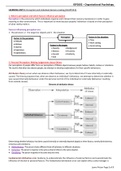IOP2602 – Organisational Psychology
LEARNING UNIT 3: Perception and Individual decision-making (CHAPTER 3)
1. What is perception and which factors influence perception
Perception is the process by which individuals organise and interpret their sensory impressions in order to give
meaning to their environment. This is important to know because peoples’ behaviour is based on their perception
of what reality really is.
Factors influencing perception are:
1. the perceiver, 2. the target (or object) and 3. the situation
Perception Factors in the situation:
Factors in the perceiver:
• Time
• Attitude
• Work setting
• Motives
Factors in the target: • Social setting
• Interest
• Novelty • Background
• Experience
• Motion • Proximity
• Expectations
• Sounds • Similarity
• Size
2. Personal Perception: Making Judgements about Others
Our perceptions of people differ from our perceptions of lifeless objects because people harbour beliefs, motives or intentions.
The result is that when we observe people, we attempt to develop explanations for their specific behaviours.
Attribution theory occurs when we observe others behaviour, we try to determine if it was internally or externally
caused. The theory proposes that, when we observe an individual’s behaviour, we attempt to determine whether it
was caused internally (behaviour under the personal control of the individual) or externally (behaviour resulting
from outside causes).
Elements of attribution theory
Determining whether behaviour has been caused internally or externally depends largely on three factors, namely distinctiveness,
consensus and consistency.
• Distinctiveness. The person shows different kinds of behaviour in different situations.
• Consensus. The person’s response is the same as that of others to the same situation.
• Consistency. The person responds in the same way over time.
Fundamental attribution error tendency to underestimate the influence of external factors and overestimate the
influence of internal or personal factors. The fundamental attribution error can explain why a sales manager is
Lyana Petzer Page 1 of 5
, IOP2602 – Organisational Psychology
prone to attribute the poor performance of her sales agents to laziness rather than to the innovative product line
introduced by a competitor.
Self-serving bias the tendency for individuals to attribute their own successes to internal factors and put the blame
for failures on external factors.
Individuals and organisations also tend to attribute their own successes to internal factors, such as ability or effort,
while blaming failure on external factors, such as bad luck or unproductive co-workers. People also tend to
attribute ambiguous information as relatively flattering and accept positive feedback while rejecting negative
feedback.
Common shortcuts in Judging Others
The shortcuts we use in judging others are frequently valuable: they allow us to make accurate perceptions rapidly
and provide valid data for making predictions.
Selective perception tendency to selectively interpret what one sees on the basis of one’s interests, background,
experience and attitudes. Any characteristic that makes a person, an object, or an event stand out will increase the
probability that we will perceive it. It allows us to “speed-read” others, but not without the risk of drawing an
inaccurate picture. Because we see what we want to see, we can draw unwarranted conclusions from an
ambiguous situation.
Halo effect the tendency to draw a general impression about an individual on the basis of a single characteristic.
Contrast effects an evaluation of a person’s characteristics that is affected by comparisons with other people
recently encountered who rank higher or lower on the same characteristics. We don’t evaluate a person in
isolation.
Stereotyping judging someone on the basis of one’s perception of the group to which that person belongs. We rely
on generalisations because they help us making decisions quickly.
One specific manifestation of stereotypes is profiling – a form of stereotyping in which a group of individuals is
singled out, typically on the basis of race or ethnicity, for intensive inquiry, scrutiny, or investigation.
Specific Applications of Shortcuts in Organisations
People in organisations are always judging each other. Managers must appraise their employees' performances.
We evaluate how much effort our co-workers are putting into their jobs. Team members immediately 'size up' a
new person
Employment interview – a major input into who is hired and who is rejected in an organisation. Research has
shown that we form impressions of others within a tenth of a second, based on our first glance of them.
Performance expectations – people attempt to validate their perceptions of reality even when those perceptions
are faulty.
• Self-fulfilling prophecy A situation in which a person inaccurately perceives a second person, and the
resulting expectations cause the second person to behave in ways consistent with the original perception.
Performance evaluation – very much dependant on the perceptual process. Subjective evaluations of
performance, though often necessary, are problematic because all the errors we’ve discussed thus far affect them.
3. The Link between Perception and Individual Decision making
All elements of problem identification and the decision-making process are influenced by perception:
• Problems must be recognised.
• Data must be selected and evaluated.
Perception is linked to individual decision-making, as individuals think and reason before they act. It is because of this that an
understanding of how people make decisions could be helpful when explaining and predicting their behaviour.
Lyana Petzer Page 2 of 5





